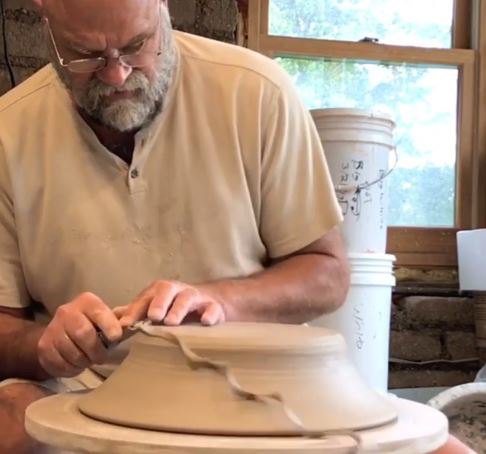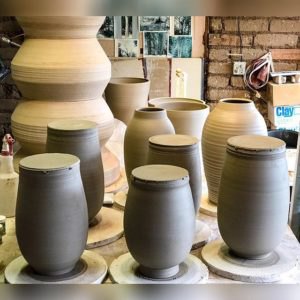Podcast: Play in new window | Download
Frank Nemick | Episode 339

 Frank Nemick’s work flows from his subconscious. Frank explores his psyche’s despair and hope. Frank tries to explore humanity’s despair and hope. By using abstraction and irony to convey these basic human feelings, Frank tries to show our fragility and our strength. And our folly.
Frank Nemick’s work flows from his subconscious. Frank explores his psyche’s despair and hope. Frank tries to explore humanity’s despair and hope. By using abstraction and irony to convey these basic human feelings, Frank tries to show our fragility and our strength. And our folly.
Frank is influenced by his past career as a firefighter. Seeing suffering and loss daily, despair is often a foregone conclusion. Observing people cope, leads to hopefulness. A background in philosophy helps to inform Frank’s work with hope in the face of despair, and of the angst of being human.
Frank tries to offset despair with hope, and beauty. To bring some respite to the human condition.
It is Frank’s way of coping.

SPONSORS


Number 1 brand in America for a reason. Skutt.com

For all your ceramic needs go to Georgies.com

Why the allure of big?
I love small things that are well done, with my hands I can’t really do that, that would be harder for me than big. But something about scale just is meaningful to me, whether it’s sculptures or pots or paintings and my gas kiln is of a sufficient size. I specifically built it to do some big pots I was working on. So between that and the wheels I have and the studio I have, I figure I am really wasting myself and my equipment if I don’t work on these big things.

What does that mean that you are wasting yourself?
You know I am not sure if that’s a good choice of words but maybe I would regret if I hadn’t worked on some big things like this. I mean even if they ultimately don’t sell I think I would still want to do them just to have that sense of creation and accomplishment. A lot of the time I think it’s important just to make and create stuff regardless of whether you are going to find it sellable. I am in a position having a retirement income where ya I want to supplementary income and I do need it but it’s not what I am depending on the live.

How did you learn to throw big?
Just by trying basically. I initially starting by starting with bigger lumps of clay and some of the professors I have had in the past have said well you know you ought to try stacking pots and I saw somewhere people were throwing with coils and stuff like that. Frank Boyden, I think he lives up in the Portland area came and did a workshop, great potter and great sculptor and he’s one of the first ones I saw talk about the coiling method.

You mentioned that you have some back problems, how do you keep healthy now to keep doing what you do?
You know, I try to walk as much as I can. Before I hurt my back, I mean as implausible as it sounds, I like to run, job or plod. But after I hurt my back I really couldn’t do that as much. So just walk, stretch, take care of myself and know when to stop pushing myself a lot of times is what it comes down to. It’s easy sometimes to push yourself too far and then you end up either paying for it physically or by getting sick or whatever.

You have a lot of pictures of your work. Tell me how you go about making sure you take good pictures.
Well when I first retired I wasn’t sure I was going to be able to do pottery. And I knew I wanted to do something so I thought I might get into photography. I was able to buy a good camera second hand and I invested in a copy of Adobe Photoshop. Those are two of the main tools that I use. For the smaller pots I have bought a graduated background to take photos with,which makes it easy. The bigger pots, especially if you are entering shows it is important to have quality pictures. I would put up some kind of background and try to take photos with them that way. That just wasn’t working so I got back into the Adobe Photoshop and started learning how to mask my pots which basically means cutting them out of the photo they are in and pasting them into a flat black background, so there is nothing in the background distracting you from the piece itself.

How do you go about pricing your work?
Oh that’s tough. A lot of it is, I think to myself, how much time and effort do I have in this? Do I want to make more of these? If I have a mug that has a lot of carving on it or something , do I want to sell those if I am not making what I think I should on them? A lot of what I do I is I will check out the competition. When I first got started I didn’t want to undercut anybody. That was really emphasized in school. So I check out the competition and try to price my stuff accordingly.

How do you determine who your competition is?
People that I like their pots or like their work.
How would you describe the value of Instagram for you?
Well there’s definitely been a monetary gain from being on Instagram.But more than that, I am in a remote location as several of the people you have interviewed are, and just the community that I get from Instagram. Seeing people write comments on posts and commenting back to them. There are several people, we have followed each other from the very beginning.

How long have you been retired?
Seven years. Almost seven years. Six and a half.
Now that you have been a professional potter for seven years, what is one thing you would do differently and what is one thing you would do exactly the same?
Well, I think I would get involved in Instagram sooner. I always wished I would have been able to continue my education and get an MFA but at some point I am not sure it is as important in a lot of respects as I may have thought it was. And one thing I would do exactly the same is I am glad I made my kiln the size it is. That I wouldn’t change. I often wished I could have been an artist or potter through my life, but actually the experience that I had as being a firefighter I wouldn’t give up now that I have gone through it.

Book

Contact:
Instagram: @franknemick